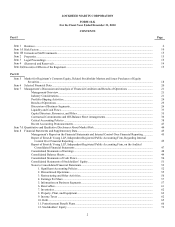Lockheed Martin 2010 Annual Report Download - page 16
Download and view the complete annual report
Please find page 16 of the 2010 Lockheed Martin annual report below. You can navigate through the pages in the report by either clicking on the pages listed below, or by using the keyword search tool below to find specific information within the annual report.8
crew exploration vehicle, an advanced crew capsule design utilizing state-of-the-art technology for human exploration beyond low
earth orbit. Through ownership interests in two joint ventures, Space Transportation Systems also includes expendable launch services
for the U.S. Government (United Launch Alliance) and Space Shuttle processing activities (United Space Alliance). The Space Shuttle
is expected to finish its final flight mission in 2011, and our programs involving its launch and processing activities will end at that
time.
Competition
Our broad portfolio of products and services competes against the products and services of other large aerospace, defense, and
information technology companies, as well as numerous smaller competitors (particularly in the IS&GS segment). We often form
teams with other companies that are competitors in other areas to provide customers with the best mix of capabilities to address
specific requirements. In some areas of our business, customer requirements are changing to encourage expanded competition, as with
the commercial access to space initiative. Principal factors of competition include: affordability; technical and management capability;
the ability to develop and implement complex, integrated system architectures; financing and total cost of ownership; release of
technology; past performance; and our ability to provide timely solutions.
The competition for foreign sales is subject to a wide variety of additional U.S. Government stipulations (e.g., export
restrictions, market access, technology transfer, industrial cooperation, and contracting practices). We may compete against both
domestic and foreign companies (or teams) for contract awards by foreign governments. International competitions also may be
subject to different laws or contracting practices of foreign governments that may impact how we structure our bid for the
procurement. In many international procurements, the purchasing government’s relationship with the U.S. and its industrial
cooperation programs are also important factors in determining the outcome of a competition. It is common for international
customers to require contractors to comply with their industrial cooperation regulations, sometimes referred to as offset requirements,
and we have undertaken foreign offset agreements as part of securing some international business. For more information concerning
offset agreements, see “Contractual Commitments and Off-Balance Sheet Arrangements” in Management’s Discussion and Analysis
of Financial Condition and Results of Operations beginning on page 39 of this Form 10-K.
Patents
We routinely apply for and own a substantial number of U.S. and foreign patents related to the products and services we
provide. In addition to owning a large portfolio of intellectual property, we also license intellectual property to and from third parties.
The U.S. Government has licenses in our patents that are developed in performance of government contracts, and it may use or
authorize others to use the inventions covered by our patents for government purposes. Unpatented research, development, and
engineering skills also make an important contribution to our business. Although our intellectual property rights in the aggregate are
important to the operation of our business, we do not believe that any existing patent, license, or other intellectual property right is of
such importance that its loss or termination would have a material adverse effect on our business taken as a whole.
Raw Materials and Seasonality
Aspects of our business require relatively scarce raw materials. We historically have been successful in obtaining the raw
materials and other supplies needed in our manufacturing processes. We seek to manage raw materials supply risk through long-term
contracts and by maintaining a stock of key materials in inventory.
Aluminum and titanium are important raw materials used in certain of our Aeronautics and Space Systems programs. Long-term
agreements have helped enable a continued supply of aluminum and titanium. Carbon fiber is an important ingredient in the composite
material that is used in our Aeronautics programs, such as the F-35. Nicalon fiber also is a key material used on the F-22 aircraft. One
type of carbon fiber and the nicalon fiber that we use currently are only available from single-source suppliers. Aluminum lithium,
which we use for F-16 structural components, also is currently only available from limited sources. We have been advised by some
suppliers that pricing and the timing of availability of materials in some commodities markets can fluctuate widely. These fluctuations
may negatively affect price and the availability of certain materials, including titanium. While we do not anticipate material problems
regarding the supply of our raw materials and believe that we have taken appropriate measures to mitigate these variations, if key
materials become unavailable or if pricing fluctuates widely in the future, it could result in delay of one or more of our programs,
increased costs, or reduced award fees.
No material portion of our business is considered to be seasonal. Various factors can affect the distribution of our sales between
accounting periods, including the timing of government awards, the availability of government funding, product deliveries, and
customer acceptance.
Government Contracts and Regulation
Our businesses are heavily regulated in most of our fields of endeavor. We deal with numerous U.S. Government agencies and
entities, including all branches of the U.S. military, the Departments of Defense, Homeland Security, Justice, Commerce, Health and
Human Services, Transportation, and Energy, the U.S. Postal Service, the Social Security Administration, the Federal Aviation
























